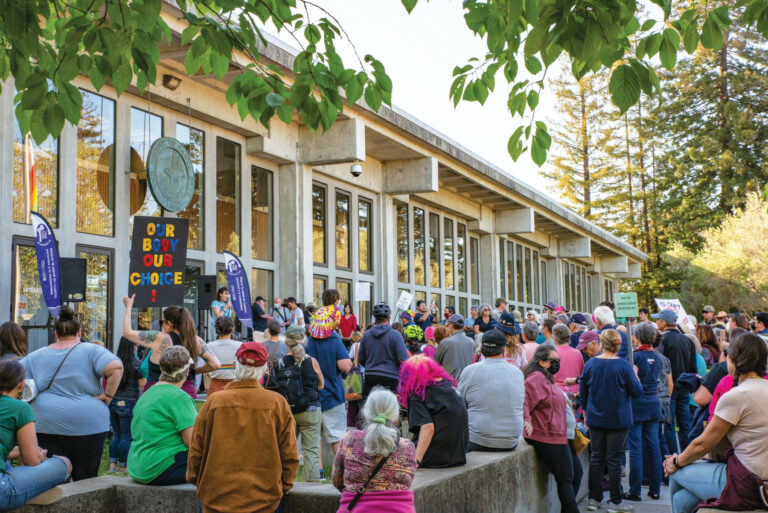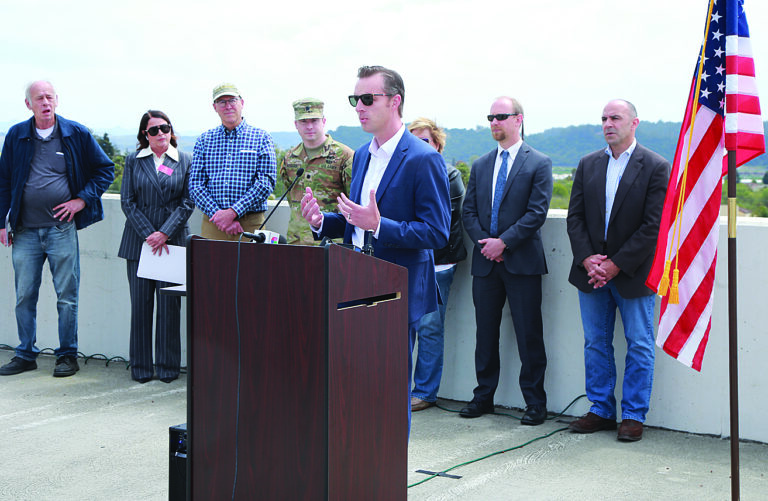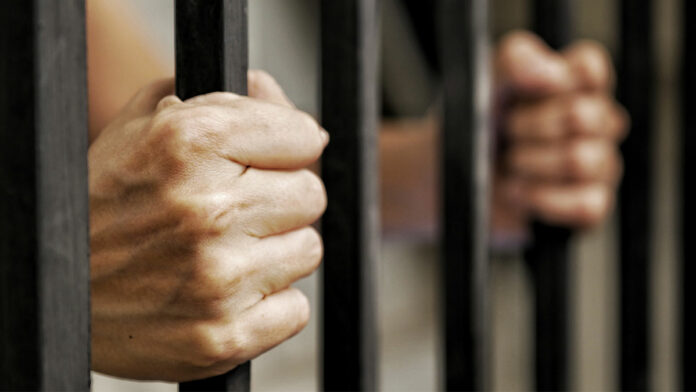Mas Hashimoto, a devout defender of civil rights whose name became synonymous with his hometown after decades of service in education, community volunteerism and historic preservation, and whose unrelenting willingness to speak, write and teach about the plight of Japanese Americans during World War II made him a nationally-recognized public speaker and celebrated member of the Japanese American Citizens League (JACL), died Monday morning. He was 86.
Hashimoto had battled pulmonary fibrosis for the past three years and was recently hospitalized with complications from the disease, his wife Marcia says. The night before he died, he and Marcia relaxed in their Watsonville home, and watched the musical “Flower Drum Song,” harkening back to their days as young sweethearts when they would travel up to San Francisco to watch light opera.
“That was the last thing we did before saying goodnight,” Marcia says.
Born in Watsonville to Japanese immigrants on Sept. 15, 1935, Hashimoto and his family were among the roughly 120,000 Japanese Americans that were ripped from their homes and incarcerated by the U.S. government in 1942, months after Japan’s attack on Pearl Harbor during World War II. After the prisons were closed in 1945 and Japanese Americans were set free, Hashimoto returned home and graduated from Watsonville High School, Monterey Peninsula College and San Jose State University before becoming a history teacher at his alma mater.
His imprisonment served as the driving force behind his 36 years of teaching, decades of community service and his unreserved and unwavering advocacy for civil rights that went beyond Japanese American issues. Hashimoto told the story of his imprisonment at the Salinas Assembly Center and Poston Camp II in Arizona to anyone that would listen. His audiences included high school and college classes, hundreds gathered at social justice rallies and thousands of viewers that clicked on his TED talk.
“We’ve clearly lost an icon in our community, an icon in our region and, really, in our country,” says author and historian Geoffrey Dunn. “He was the clear conscience of our community when it came to issues involving racism and social injustice. He never backed down and he never went soft. That’s a major loss. But I want to say that his work sustains itself in all the students he taught, in all the students he met with, in all community members he met with, all the community activists he worked with. That work will be sustained. It will live on.”
He never used this platform to gain notoriety, says Dunn, who as a 17-year-old high school student was inspired by Hashimoto to research and write about Santa Cruz County’s history. Rather, Hashimoto spoke about his experience to make sure his community never forgot the injustices that were committed against thousands of U.S. citizens, and to assure that they learned from the mistake.
“Part of his legacy is that he would not let this community forget that grave social injustice. That’s one pillar of his legacy, but it has a corresponding pillar, and that is that he never allowed it to happen again to any community,” Dunn says. “With Mas, it wasn’t just about the past but it was about the present. A lot of people will condemn the past but they won’t bring it up to the present. Mas always brought it back to the present.”
In 1992, Hashimoto organized a graduation ceremony for the Nisei—a person born in the U.S. or Canada whose parents were immigrants from Japan—students of the Class of 1942 who were denied their graduation because of internment. Watsonville High was the first school in the nation to remember and honor the Nisei graduates, and UC Berkeley followed later that year.
Then, 10 years later, on the 60th anniversary of the forced removal of Japanese Americans, he organized the only reenactment of the infamous day. Called “Liberty Lost … Lessons in Loyalty,” the massive undertaking shut down a large swath of Beach Street and gained international news coverage. Hundreds of volunteers, city officials, students, civic organizations and businesses came together to pull off the event under Hashimoto’s direction.
“He was a perfectionist in a lot of ways. He had a vision that he wanted to see realized and that took a lot of work and a lot of attention to detail. He was very, very determined that his vision was going to come out,” says Santa Cruz County Administrative Officer Carlos Palacios, who was then Watsonville’s city manager. “He viewed it as a tribute to the community that had suffered from internment. In my view, that’s why he took it so seriously.”
The reenactment happened just a few months after the Sept. 11 attacks, a time in which anti-Muslim rhetoric and violence were spiking. Author, teacher and historian Sandy Lydon was a member of the reenactment’s steering committee. In a column published in the Pajaronian, Lydon says the committee had discussions about possibly canceling the reenactment, but the news of the racially motivated attacks strengthened the group’s resolve to move forward.
It was Hashimoto’s leadership, Lydon says, that guided the committee to the finish line.
“His concern about civil rights was not confined to just Japanese issues,” Lydon says. “He was alert and because he was such a powerful representative of what happened when civil rights get burned up, personally, he had a presence—he’s been there and done that.”
Those two events were just a sampling of Hashimoto’s contributions to the community. He was a co-founding officer of the teachers’ union for the Pajaro Valley Unified School District and a champion for girls’ sports and inclusive athletics through his after-school bowling club, which offered physically and mentally disabled students an avenue into competitive sports. In all, he taught nearly 7,000 students before retiring from education in 1996. His pupils include politicians, CEOs and community organizers near and far.
“Mas was a giant,” Palacios says. “He was so well respected by everyone from across the political spectrum. Whether people are on the left, on the right, no matter what ethnicity they were, no matter where they were from or what they did, they respected him.”
Marcia says that Hashimoto’s passion for teaching was largely due to the fact that he saw himself in many of his students, the majority of whom were of Latinx descent. He worked in the Pajaro Valley’s bountiful agricultural fields every summer from the age of 10 until he graduated from college. He used the money he made as a farmworker to help his family make ends meet and then to pay for his college education.
Hashimoto was also the editor of the Watsonville-Santa Cruz JACL monthly newsletter for more than 25 years and was a regular volunteer for the Watsonville Buddhist Temple, serving as the editor for the organization’s 60th- and 100th-anniversary books. Because of Hashimoto and Marcia, Lydon says, the Watsonville-Santa Cruz JACL is one of the most revered chapters of the national organization.
“There are people, both Japanese and not, throughout the region who join that [chapter] because it is so strong and because the information in their newsletter is so current,” Lydon says. “[The members] know that if there’s something that needs their attention that they missed, that Mas will get it to them. You can count on Mas.”
It was through his work with the JACL that Hashimoto made close relationships with the late Secretary of Transportation Norman Y. Mineta—the namesake of the San Jose International Airport—and former State Assemblyman Floyd Mori, who also previously served as the JACL National President and National Executive Director/CEO. Mori described Hashimoto as a “genuine” person whose commitment to telling the truth about Japanese imprisonment never waivered.
“There are not a lot of people that for years and for decades maintain a very strong commitment to a cause,” Mori says. “Mas was one of those rare people that never tired of telling his story, and because it meant so much to him people listened. You can sense that it was not just an intellectual discussion. It was something that came from his heart, and I think that’s what kept him going.”
National JACL Executive Director David Inoue says that Hashimoto’s “keen sense of justice and the relevance of the Japanese American story to so many other racial injustices will be missed.”
“We recently lost Secretary Norman Mineta, a very public figure from our community. Mas was just as important for the work he put in, especially in the Watsonville-Santa Cruz community,” Inoue says. “He built bridges between JACL and the wider community in the true spirit of coalition and community building.”
In retirement, Hashimoto was an avid golfer, skier, photographer and world traveler. Marcia says that they stayed in Africa’s famed Treetops lodge, saw shark feedings in Bora Bora, experienced the Carnival in Brazil and ventured multiple times through Asia and Europe.
“You learn so much about your own country when you travel and see other parts of the world,” Marcia says. “But in traveling all over the world, he always felt that there was no better place to live your life than Watsonville. The community, the people, the environment, was just a thing that touched his heart. It was such a beautiful life for him and he always felt grateful.”
This love for Watsonville dates back to his childhood and his imprisonment, Marcia says. Local teachers many times visited their students at the Salinas Assembly Center and even sent books to their former pupils while they were imprisoned. And when local families were transferred to Poston, many Watsonville residents would make the 500-mile trek to visit their friends in Arizona.
“Watsonville was one of the few towns that did support the Japanese Americans before and after they were incarcerated,” Marcia says. “When they were released from the camps there were some people that met some of the families returning at the train station and bus station. The reason why Mas and other families have such devotion for and gratitude toward Watsonville is because even in those racist times and those hard, difficult times when the nation was being discriminatory against Asian Americans, people in Watsonville were wonderfully supportive.”
Just a dozen years after he was imprisoned, Hashimoto was drafted into the U.S. Army in 1958 and was assigned to the top-secret Chemical Section of the Sixth U.S. Army Headquarters in the Presidio of San Francisco. His service to his country, Marcia says, was something he was very proud of.
Palacios says that this was one of his many admirable qualities. Hashimoto and Marcia volunteered to help with the City of Watsonville’s Fourth of July parade every year, and would often be among the first people to arrive early in the morning.
“When I think of him, I often think that despite all that he suffered from the American government he still was a very proud patriot, he was a very proud member of this community,” Palacios says.
Despite his deteriorating physical health, Hashimoto continued to speak about his experience. The pandemic produced challenges, Marcia says, but it also provided Hashimoto with the opportunity to speak to groups over Zoom and focus his efforts on his writing. Just last month, Hashimoto wrote the lion’s share of articles in the Watsonville-Santa Cruz JACL newsletter and opined in local newspapers about issues before voters in the June 7 primary.
As he was in and out of hospitals over the past few weeks, Hashimoto told Marcia he had one final goal he wanted to accomplish: be alive in November.
“He was determined. He told me, ‘Gosh, Marcia. I hope I’m still alive in November because I got to vote,’” she says. “I know what he would want to say to the public today is please vote. Make your voice heard. It’s such an important part of what he fought for.”






















